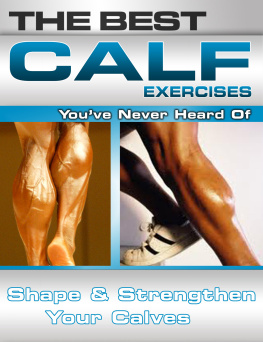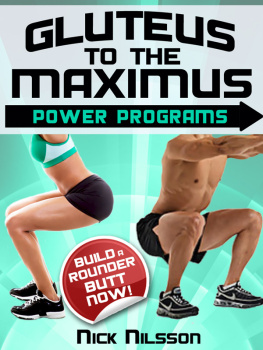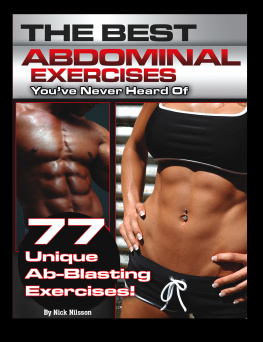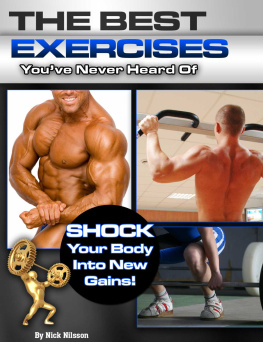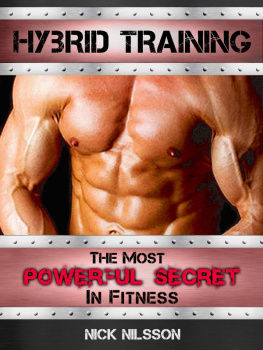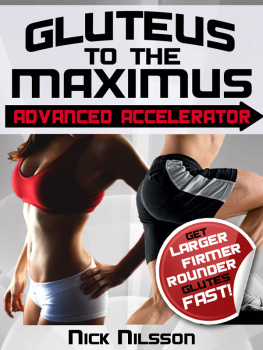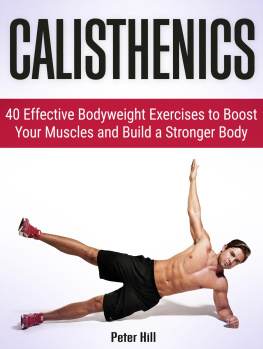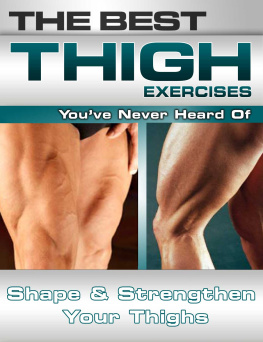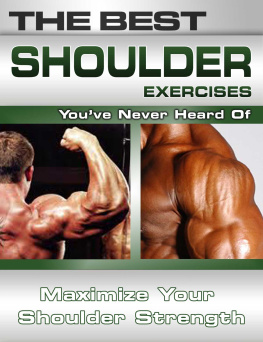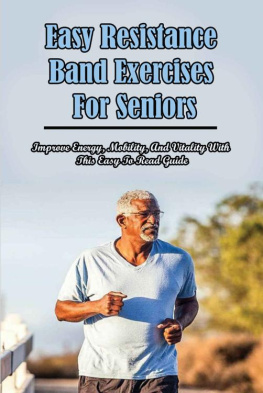The Best Calf Exercises Youve Never Heard Of
Shape and Strengthen Your Calves
By Nick Nilsson

Prior to beginning any exercise program, you must consult with your physician. You must also consult your physician before increasing the intensity of your training. The information in this book is intended for healthy individuals. Any application of the recommended material in this book is at the sole risk of the reader, and at the readers discretion. Responsibility of any injuries or other adverse effects resulting from the application of any of the information provided within this book is expressly disclaimed.
Price World Publishing
www.PriceWorldPublishing.com
Copyright 2011 by Nick Nilsson
All rights reserved. Neither this book, nor any parts within it may be sold or reproduced in any form without permission.
eISBN: 9781936910106
Table of Contents
Introduction:
In this book you will find fantastic calf exercises.
How To Do It:
Read through the exercise descriptions thoroughly so you know exactly what the exercise is going to accomplish, how to execute it properly and safely and how to best incorporate the exercise into your workouts.
Common Errors:
The Common Errors section of each exercise will let you know some of the typical ways the exercise is done improperly so you can take steps to correct yourself before they even happen!
Tricks:
Finally, be sure to read through all the Tricks for each exercise. There are tips that will help you get even more out of these already amazing exercises.
CALF EXERCISES
Calf Rock-Ups
Why Is This Exercise So Effective?
This is a bodyweight contracted position exercise for the calves that can be done anywhere at any time because it requires no equipment.
It is also an excellent finishing movement for the soleus muscles because it places them in their most contracted position possible. This ensures full muscle fiber stimulation.
How To Do It
- Squat down with your legs completely bent so your hamstrings are touching your calves.
- Rise up on your toes and squeeze your calves hard. This is the most contracted position possible for the soleus muscle.
- This exercise can be done with your back against a wall or holding onto something in front or to the side for balance. Doing this exercise with your back against a wall can, however, be hard on your knees.
- To increase the range of motion and include a stretch component, do these with your toes on a raised surface. The stretch will not be huge, but it will be something.

How to incorporate this exercise into your workouts:
This exercise is excellent as a finishing exercise.
- Since it uses little to no weight other than your bodyweight, it should be used after your calves are already fatigued.
- It is also useful for working your calves when you are travelling as it requires no equipment to do.
Common Errors
1. Not squeezing hard at the top
The top is most beneficial part of this exercise. Squeeze hard to get the most out of it.
2. Going too fast
This movement should be done slowly and deliberately, rather than in a fast, pumping style.
Tricks
1. Increasing resistance
There are several ways to increase resistance in this exercise.
- Hold a plate or dumbbell on your knees.
- Another way to add resistance is to put your forearms on your knees, then hold your hands under something solid. Use hand pressure as resistance.
2. Using the Smith machine
This exercise can also be done using the Smith machine as resistance.
- Lower the bar to a point about a foot and a half off the ground. Use a foamy barbell pad if you have one or even a towel rolled around the bar.
- Place your feet slightly behind the bar, then tuck your knees under the bar so that the foamy pad is on the top of the thighs, just above the knees.
- You will be down in an extreme squatting position with your heels slightly off the ground.
- Rise up onto the balls of your feet, squeezing hard.
- Keep tension in your thighs to prevent knee stress.
- Hang onto the bar to allow you to reset it at a moments notice.
- These can be done one leg at a time, with your other leg behind as if you are in the bottom of the lunge position.
Full Range Calf Raises
Why Is This Exercise So Effective?
This is a bodyweight exercise that takes the calf muscle through its absolute fullest range of motion, from maximal stretch through the mid-range, all the way to the peak contraction.
No other calf exercise works the gastrocnemius through its entire anatomical range of motion. The muscle contraction you can achieve by doing this is incredible.
How To Do It

- This exercise is done one leg at a time.
- Set up with the balls of your foot on a raised block (any raised surface will work).
- Keeping your leg as straight as possible (push on your knee if you have to), bend over as though touching your toes.
- Hold onto something for balance.
- Stretch your heel down as far as possible and stretch your upper body down as far as possible without bending your legs. This is the maximal stretch position for the calves and you should feel an intense stretch.
- Rise up as far as you can on your toes while staying bent over.
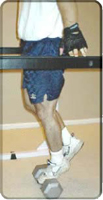
- At full extension of the ankle from the bent over movement and without releasing the tension in the calves, straighten up at the waist so you are now in a one-legged calf raise position. Your foot position will look as though you are part- way through the calf-raise movement already.
- Use your hands to help you get into that position by climbing them up whatever you are holding on to.
- Continue up to the full contraction of the calves by finishing the calf raise movement. Squeeze your calf as hard as you can.
- Lower yourself to the bottom position of the standing calf raise then bend over at the waist then repeat.
How to incorporate this exercise into your workouts:
This exercise can be placed anywhere in your workouts. It is perfect as a stand-alone exercise. It works the calves through their entire anatomical range of motion in one exercise.
Common Errors
1. Moving too fast
Take your time as you do the movement to ensure your calves are getting maximum tension throughout the entire range of motion. This exercise is all about tension, not how many reps you can do or how much weight you can use.
2. Releasing the tension
This can happen when you are straightening up after finishing the bent-over phase. Be sure to keep the tension on the calf muscle as you straighten up. What makes the exercise so effective is that you are taking the muscle through its entire anatomical range of motion under tension the whole way.

